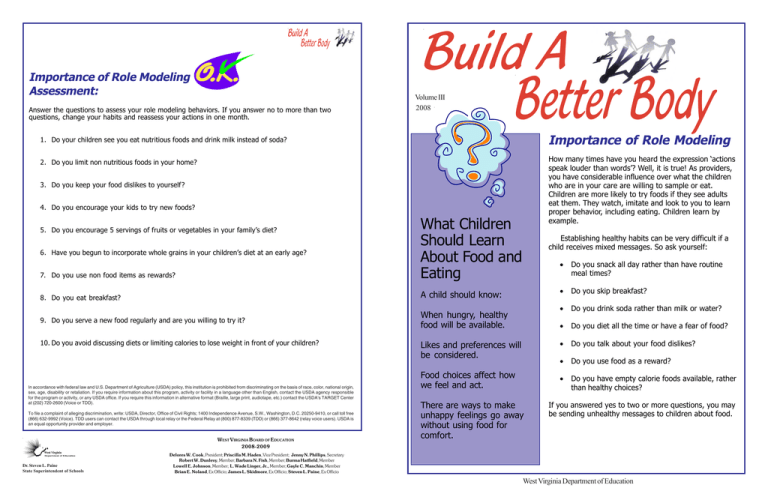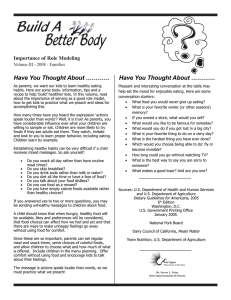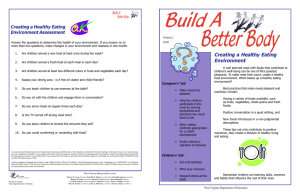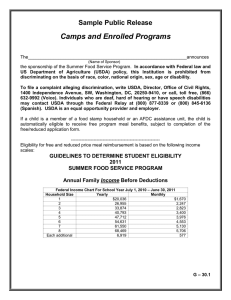Better Body Build A
advertisement

Build A Better Body Importance of Role Modeling Assessment: Answer the questions to assess your role modeling behaviors. If you answer no to more than two questions, change your habits and reassess your actions in one month. Build A Volume III 2008 Better Body Importance of Role Modeling 1. Do your children see you eat nutritious foods and drink milk instead of soda? How many times have you heard the expression ‘actions speak louder than words’? Well, it is true! As providers, you have considerable influence over what the children who are in your care are willing to sample or eat. Children are more likely to try foods if they see adults eat them. They watch, imitate and look to you to learn proper behavior, including eating. Children learn by example. 2. Do you limit non nutritious foods in your home? 3. Do you keep your food dislikes to yourself? 4. Do you encourage your kids to try new foods? 7. Do you use non food items as rewards? What Children Should Learn About Food and Eating 8. Do you eat breakfast? A child should know: 9. Do you serve a new food regularly and are you willing to try it? When hungry, healthy food will be available. 5. Do you encourage 5 servings of fruits or vegetables in your family’s diet? 6. Have you begun to incorporate whole grains in your children’s diet at an early age? 10. Do you avoid discussing diets or limiting calories to lose weight in front of your children? In accordance with federal law and U.S. Department of Agriculture (USDA) policy, this institution is prohibited from discriminating on the basis of race, color, national origin, sex, age, disability or retaliation. If you require information about this program, activity or facility in a language other than English, contact the USDA agency responsible for the program or activity, or any USDA office. If you require this information in alternative format (Braille, large print, audiotape, etc.) contact the USDA’s TARGET Center at (202) 720-2600 (Voice or TDD). To file a complaint of alleging discrimination, write: USDA, Director, Office of Civil Rights; 1400 Independence Avenue, S.W., Washington, D.C. 20250-9410, or call toll free (866) 632-9992 (Voice). TDD users can contact the USDA through local relay or the Federal Relay at (800) 877-8339 (TDD) or (866) 377-8642 (relay voice users). USDA is an equal opportunity provider and employer. WEST VIRGINIA BOARD OF EDUCATION 2008-2009 Dr. Steven L. Paine State Superintendent of Schools Establishing healthy habits can be very difficult if a child receives mixed messages. So ask yourself: Likes and preferences will be considered. Food choices affect how we feel and act. There are ways to make unhappy feelings go away without using food for comfort. Do you snack all day rather than have routine meal times? Do you skip breakfast? Do you drink soda rather than milk or water? Do you diet all the time or have a fear of food? Do you talk about your food dislikes? Do you use food as a reward? Do you have empty calorie foods available, rather than healthy choices? If you answered yes to two or more questions, you may be sending unhealthy messages to children about food. Delores W. Cook, President; Priscilla M. Haden, Vice President; Jenny N. Phillips, Secretary Robert W. Dunlevy, Member; Barbara N. Fish, Member; Burma Hatfield, Member Lowell E. Johnson, Member; L. Wade Linger, Jr., Member; Gayle C. Manchin, Member Brian E. Noland, Ex Officio; James L. Skidmore, Ex Officio; Steven L. Paine, Ex Officio West Virginia Department of Education TIPS These concepts are crucial in a child’s emotional relationship with food. To assure children these concepts will happen, caregivers should practice the following strategies: When hungry, healthy food will be available by setting regular meal and snack times, serving choices of colorful, appealing foods. Likes and preferences will be considered when children may choose what and how much of what is offered and they are included in menu planning. Food choices affect how they feel and act when they learn how food helps the body and why a variety of foods are on the table. There are ways to make unhappy feelings go away without using food for comfort. The message is actions speak louder than words, so we must practice what we preach! Build A Better Body Actions: Like reading, writing, hand washing and good personal hygiene, learning good food habits is a life skill that can help children live a healthy, satisfying life. Establish a meal time routine that children can count on to avoid the ‘grumpy hungrys’. Kids need to eat every three to four hours. Never skip meals, especially breakfast. Take moderate portions. Turn off the TV or other distractions during meal time. Make conversation in positive tones and about pleasant topics.(See Conversation Starters) Encourage children to try new foods with a ‘no-thank you bite’, however avoid using food as a reward. Serve a variety of foods and make interesting connections to new foods. If possible, let children help you prepare foods, set the table, put out the napkins or toss a salad. Incorporate physical activity in the day to build a healthy appetite. This helps you take care of yourself, too. Stay informed of proper nutrition needs through reliable resources, workshops, or training opportunities. A nurturing place to eat is caring, calm and respectful and safe from injury like choking. Build A Better Body NUTRITION TOOL! Tutti Fruitti Cones (six servings) Ingredients: 1 banana, sliced 1 cup mandarin orange 1 1/2 cups pineapple chunks, drained 1 cup strawberries, sliced 1/2 cup blueberries 3/4 cup lowfat lemon yogurt 6 ice cream cones Method: Combine fruit and yogurt. Spoon 3/4 cup fruit in cone and serve immediately. ACTIVITY TOOL! Tutti Fruitti Scramble Have children draw or color pictures of different fruit and vegetables on sheets of 8.5x11 size paper. Tack pictures to the floor with sticky tape, creating a large mat. Announce fruit or vegetable names and children must place a hand or foot on the correct picture. When a child has all hands and feet on mat, another child will join in the game. See how many kids can fit on the mat. (Think of the game ‘Twister’) Conversation Starters: What food you would never give up eating? What is your favorite winter (or other seasons) memory? If you owned a store, what would you sell? What would you like to be famous for someday? What would you do if you got lost in a big city? What is your favorite thing to do on a rainy day? What is the hardest thing you have ever done? Which would you choose being able to do: fly or become invisible? How long could you go without watching TV? What is the best way to say you are sorry to someone? What makes a good loser? And are you one?





